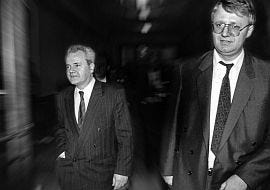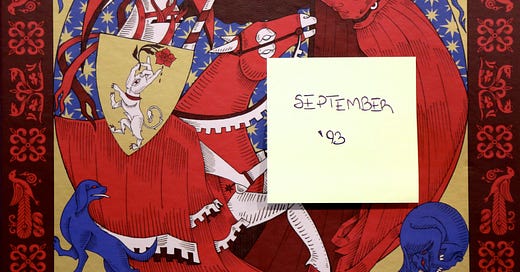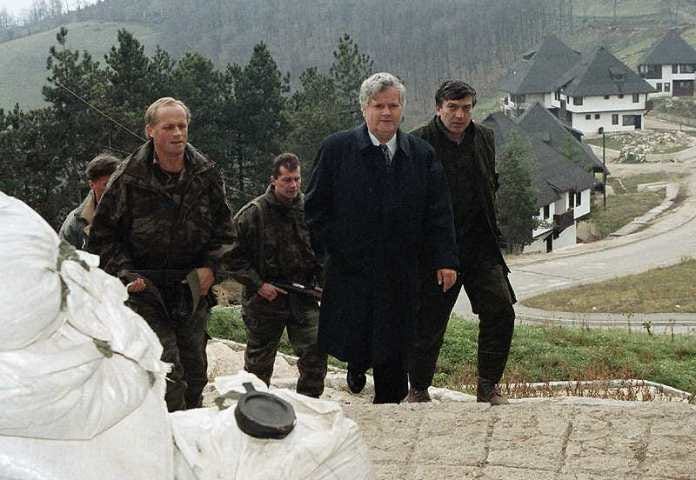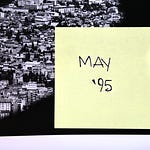September 1993.
As Sarajevo is totally encircled by Bosnian Serb forces for the first time, another failure takes place on the diplomatic level [you can listen to the latest episode of BarBalkans - Podcast here].
A new peace plan for Bosnia and Herzegovina - the Owen-Stoltenberg Plan - is presented in Geneva. It takes too many elements from the proposal on the partition of the Republic by the President of Serbia, Slobodan Milošević, and the President of Croatia, Franjo Tuđman.
But again, this compromise solution has no hope of being grounded, because it leaves Bosniaks taking the crumbs of the Republic.
The Owen-Stoltenberg Plan is over, as soon as it is presented. And this has severe implications also within each of the warring parties.
Croatia. Tuđman in crisis
Despite the apparent agreement between Croatia and Serbia on the partition of Bosnia and Herzegovina, armed clashes between the two armies start again in two Croatian areas in early September.
These clashes are caused by the Croatian attempt to win back the Maslenica Bridge - the crucial link between Zagreb and Dalmatia blown up by the Serbian army in November 1991 - eight months after the failed military operation.
The attack is successful and the bridge is reopened, but the fighting extends beyond Dalmatia. On September 9, Croatian soldiers attack Divoselo, a small town in northern Krajina.
Divoselo is razed to the ground and 67 Serbs of Croatia are slaughtered in a mass execution. This is the pretext for a furious reaction by the opposing army.
The cities of Zadar, Split, Gospić, Karlovac, Samobor, Sisak, Sibenik and even the outskirts of Zagreb are bombed. Tuđman is forced to call a cease-fire just three days later.
In Zagreb, opposition begins to undermine the President. On September 20, some prominent intellectuals harshly criticize the military intervention in Bosnia in support of the Croatian Republic of Herzeg-Bosnia.
The figures of the intervention put Tuđman in crisis. Nearly one third of 900 thousand Croats of Bosnia had to flee Posavina (the region bordering Croatia in east-central Bosnia) during the Bosnian Serb advance. Another third are in critical conditions in central Bosnia due to Bosniak attacks.
Serbia. Šešelj v. Milošević
In Serbia, the situation is not very stable. Once again, this is an effect of the tensions in Republika Srpska.
A group of soldiers - who are hostile to the enrichment of war profiteers - attempts a coup against the President Radovan Karadžić in Banja Luka. They are close to the commander of the Bosnian Serb army, Ratko Mladić
The coup fails (while the last 13 mosques of Banja Luka are destroyed), but repercussions hit Belgrade.
The leader of the Serbian Radical Party, Vojislav Šešelj, attacks Serbian President Milošević, accusing him of being the instigator of the uprising in Republika Srpska against the radical Karadžić. More importantly, he denounces that this should be a preview of what Milošević wants to do in Serbia.
Šešelj becomes more and more aggressive, to the point that he also accuses the Serbian Prime Minister, Nikola Šainović, of «dressing the homeland in mourning».
Milošević seizes the opportunity to return the accusations of being a fascist - as the coup-makers have done with Karadžić. And he threatens to bring Šešelj to court for war crimes committed by his followers in Bosnia and Herzegovina.
Accusations of war crimes escalate between the two politicians, revealing that the entire Serbian political establishment is somehow involved in the ongoing atrocities in Bosnia.

Bosnia. The fourth war front
But the most delicate situation is within the Bosniak establishment.
It all starts with an unexpected revival of the Owen-Stoltenberg Plan, thanks to the initiative of the politician that has given the greatest contribution to bury the agreement in August. The President of Bosnia and Herzegovina, Alija Izetbegović.
Although very few ceasefires break the continuing fighting, Izetbegović confirms that he is ready to re-discuss the latest peace plan on two conditions. Firstly, the two separatist (Serbian and Croatian) Republics have to guarantee a referendum within two years to enshrine the will of the people. Secondly, the Muslim Republic has to be given a seat in the United Nations Assembly.
This is how, on September 20, the three sides meet in international waters on the British cruiser ‘Invincible’, in the Adriatic Sea. They discuss the partition of Bosnian territory, access to the sea and the special administrations of Sarajevo and Mostar.
But the Owen-Stoltenberg Plan fails again. And, once again, because of Izetbegović’ opposition, as he insists for a higher percentage of territory for Bosniaks. He is backed by a new factor: military successes in Central Bosnia and Herzegovina.
After the “Neretva 93” operational plan kicked off, Bosniaks has won back more than three thousand square kilometers. They have defeated the Croatian Defense Council (the army of the Croatian Republic of Herzeg-Bosnia) in Mostar and in the Lašva River valley, between Vitez and Travnik.
This is how Bosniaks experience a moment of nationalist enthusiasm.
An assembly composed of cultural, political and Muslim authorities decides to restore the historical name bošnjak instead of ‘Bosnian Muslim’. Despite the fact that the term has an ethnic connotation, more than an exclusively religious one. In Bosnia, all Muslims are bošnjaks, but not all bošnjaks are Muslims.
The Bosnian Parliament also endorses the political line of this informal assembly. And Izetbegović puts an end to peace negotiations: «The only choice left for us is between a just war and an unjust peace».
As a reaction, the Serbian army intensifies the bombings on Tuzla, Zenica, Maglaj, Olovo and Sarajevo. From the heights above the city, fire is opened on the Holiday Inn palace where the Parliament is meeting.
However, the hard line imposed by Izetbegović and the political establishment in Sarajevo also has a boomerang effect, on the Bosniak side itself.
Fikret Abdić - entrepreneur and politician from Velika Kladuša, founder of Agrokomerc, one of the most important Yugoslav agricultural-industrial conglomerates in the Eighties - stands against this political stance. As leader of the “moderate” wing, Abdić decides to oppose the Bosnian President. And he does more.
Counting on the unconditional support of almost 200 thousand people in Northwestern Bosnia, Abdić decides to force his hand. To be fair, he is also endorsed by Milošević and Tuđman, who are pleased to be able to count on a billionaire entrepreneur capable of breaking the Bosniak front.
The Bosnian businessman proposes to divide Bosnia and Herzegovina not into three, but into four parts. The fourth entity in the Union of the Republics of Bosnia and Herzegovina should be the region including Velika Kladuša and Bihać, where the population is 90% Muslim Bosnians.
The Bosnian government categorically refuses to accept the proposal. Abdić cuts ties with Sarajevo, accusing Izetbegović of being a fundamentalist Islamic politician.
Moreover, on September 27 he convenes a 400-member assembly that unanimously approves his proposal to establish the Autonomous Region of Western Bosnia. The capital is Velika Kladuša, Abdić is elected President, and the People’s Defense of the Autonomous Province of Western Bosnia is established as an army.
A new war front opens in Bosnia and Herzegovina.

If you know someone who can be interested in this newsletter, why not give them a gift subscription?
Here is the archive of BarBalkans - Podcast:
And here you can find a summary of the past years:

















Share this post